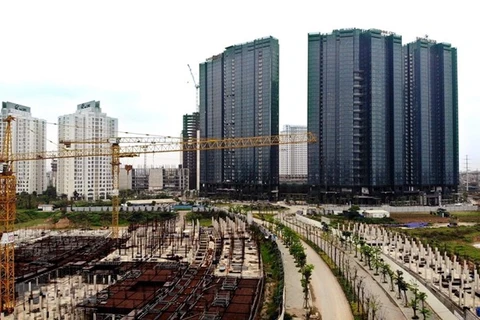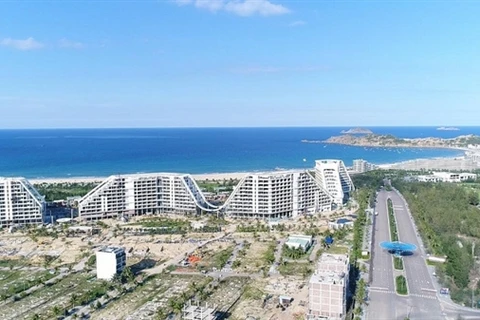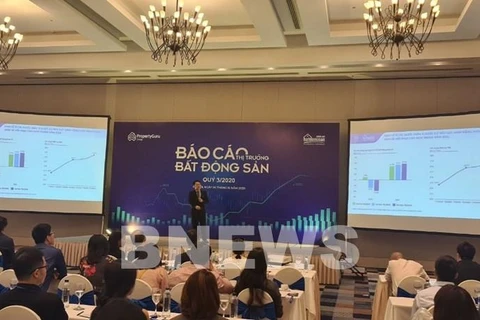Hanoi (VNS/VNA) - Domestic and foreign capital flow is expected to bolster real estate shares after the COVID-19 pandemic as many investors are paying attention to the industry.
Vietnam Construction and Import-Export Joint Stock Corporation (VCG) soared more than 50 percent in the past two months, largely because the enterprise has entered a period of stable governance, thereby focusing heavily on investment and trading activities, VCG said.
Nearly 95 percent of the VCG shares are in the hands of large investors who hold corporate governance and the number of shares circulating outside is very low, accounting for less than 5 percent.
At a previous general meeting of shareholders of Vinaconex, chairman of the company Dao Ngoc Thanh said VCG’s shareholders will benefit if VCG's shares top 50,000 VND per share (2.16 USD). He suggested VCG buy back shares then put them up for sale when prices increase.
Businesses that recorded positive growth in the second quarter also attracted investors' attention.
In the second quarter, Novaland (NVL)'s profit increased by 73 percent year-on-year. Its key resort real estate projects include Aqua City and Novaworld Ho Tram.
Khang Dien House Trading and Investment JSC (KDH)’s profit rose 125 percent with a focus on developing small and medium housing with high liquidity.
Phat Dat Real Estate Development JSC (PDR)’s profit increased by 37 percent over the same period last year.
The market is also flooded with information that is set to spur real estate stocks such as Vingroup acquiring ITA to own an industrial real estate land fund, shares of Kinh Bac City Development Share Holding Corporation (KBC) being purchased by a group of investors, Long An-Long Hau Industrial Park in southern Long An province (LHG) holding a large amount of money after shareholders divesting from the manufacturing sector and pouring into real estate projects and leaders of LDG Joint Stock Company (LDG) buying back LDG shares.
The real estate industry's second-quarter revenue exceeded VNĐ36 trillion, down 24.4 percent over the same period last year. Profit after tax was reported at 7.1 trillion VND, down 47.7 percent year-on-year.
The distribution of net profit growth of the whole industry in Q2 was equivalent to that in the first quarter. Stocks reporting negative profit growth accounted for 58 percent. Of them, 45 percent of businesses recorded profits decreasing by more than 20 percent.
The industry's ability to pay interest rates improved from a low level in the first quarter, up 4.3 percent.
The quiet real estate market due to the pandemic harmed the launching plans of real estate projects, affecting inventory settlement.
The decline in business results caused the return on average assets (ROAA) and return on average equity (ROAE) to decline to 16.3 percent and 6.6 percent, respectively.
In the second quarter, post-tax profits of real estate giants Vinhomes (VHM) and Vincom Retail (VRE) declined respectively 55 percent and 46 percent year-on-year.
For VHM, this was due to the decline in real estate transferring activities.
Meanwhile, Vincom Retail (VRE) had to set aside a support package worth 375 billion VND for clients affected by COVID-19. The interest payments for the issuance of more than 1 trillion VND worth of bonds in April also eroded the profit of the company.
Companies that have a large house fund to hand over in the second half of 2020 include Novaland, Hoang Huy Finance, Nam Long, Bamboo Capital, Ha Do and CEO Group.
Insiders said that if in the fourth quarter the progress of the handover of houses slows, the growth of business results in 2020 of some listed companies could become negative.
In 2019, total revenue and post-tax profit of businesses reached 219.4 trillion VND and 21.1 trillion VND, respectively, up 5.3 percent and 27.3 percent compared to the previous year./.
Vietnam Construction and Import-Export Joint Stock Corporation (VCG) soared more than 50 percent in the past two months, largely because the enterprise has entered a period of stable governance, thereby focusing heavily on investment and trading activities, VCG said.
Nearly 95 percent of the VCG shares are in the hands of large investors who hold corporate governance and the number of shares circulating outside is very low, accounting for less than 5 percent.
At a previous general meeting of shareholders of Vinaconex, chairman of the company Dao Ngoc Thanh said VCG’s shareholders will benefit if VCG's shares top 50,000 VND per share (2.16 USD). He suggested VCG buy back shares then put them up for sale when prices increase.
Businesses that recorded positive growth in the second quarter also attracted investors' attention.
In the second quarter, Novaland (NVL)'s profit increased by 73 percent year-on-year. Its key resort real estate projects include Aqua City and Novaworld Ho Tram.
Khang Dien House Trading and Investment JSC (KDH)’s profit rose 125 percent with a focus on developing small and medium housing with high liquidity.
Phat Dat Real Estate Development JSC (PDR)’s profit increased by 37 percent over the same period last year.
The market is also flooded with information that is set to spur real estate stocks such as Vingroup acquiring ITA to own an industrial real estate land fund, shares of Kinh Bac City Development Share Holding Corporation (KBC) being purchased by a group of investors, Long An-Long Hau Industrial Park in southern Long An province (LHG) holding a large amount of money after shareholders divesting from the manufacturing sector and pouring into real estate projects and leaders of LDG Joint Stock Company (LDG) buying back LDG shares.
The real estate industry's second-quarter revenue exceeded VNĐ36 trillion, down 24.4 percent over the same period last year. Profit after tax was reported at 7.1 trillion VND, down 47.7 percent year-on-year.
The distribution of net profit growth of the whole industry in Q2 was equivalent to that in the first quarter. Stocks reporting negative profit growth accounted for 58 percent. Of them, 45 percent of businesses recorded profits decreasing by more than 20 percent.
The industry's ability to pay interest rates improved from a low level in the first quarter, up 4.3 percent.
The quiet real estate market due to the pandemic harmed the launching plans of real estate projects, affecting inventory settlement.
The decline in business results caused the return on average assets (ROAA) and return on average equity (ROAE) to decline to 16.3 percent and 6.6 percent, respectively.
In the second quarter, post-tax profits of real estate giants Vinhomes (VHM) and Vincom Retail (VRE) declined respectively 55 percent and 46 percent year-on-year.
For VHM, this was due to the decline in real estate transferring activities.
Meanwhile, Vincom Retail (VRE) had to set aside a support package worth 375 billion VND for clients affected by COVID-19. The interest payments for the issuance of more than 1 trillion VND worth of bonds in April also eroded the profit of the company.
Companies that have a large house fund to hand over in the second half of 2020 include Novaland, Hoang Huy Finance, Nam Long, Bamboo Capital, Ha Do and CEO Group.
Insiders said that if in the fourth quarter the progress of the handover of houses slows, the growth of business results in 2020 of some listed companies could become negative.
In 2019, total revenue and post-tax profit of businesses reached 219.4 trillion VND and 21.1 trillion VND, respectively, up 5.3 percent and 27.3 percent compared to the previous year./.
VNA
























